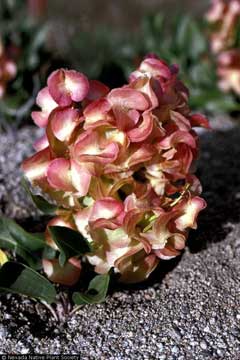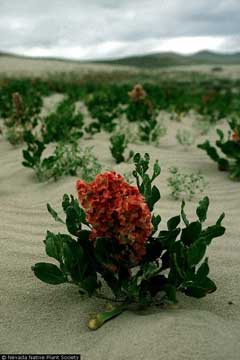 |
|
Margaret Williams @ USDA-NRCS PLANTS Database |
 |
| Margaret Williams @ USDA-NRCS PLANTS Database |
Translate this page:
Summary
Physical Characteristics

 Rumex venosus is a PERENNIAL growing to 0.5 m (1ft 8in).
Rumex venosus is a PERENNIAL growing to 0.5 m (1ft 8in).
See above for USDA hardiness. It is hardy to UK zone 4. It is in flower from July to August. The species is hermaphrodite (has both male and female organs) and is pollinated by Wind.
Suitable for: light (sandy), medium (loamy) and heavy (clay) soils and prefers well-drained soil. Suitable pH: mildly acid, neutral and basic (mildly alkaline) soils. It can grow in semi-shade (light woodland) or no shade. It prefers moist soil.
UK Hardiness Map
US Hardiness Map
Synonyms
Plant Habitats
Cultivated Beds;
Edible Uses
Edible Parts: Leaves Stem
Edible Uses:
Young leaves - cooked[105, 161, 177]. Used as greens. Young stems - cooked[105, 161, 177]. Used like rhubarb[257].
References More on Edible Uses
Medicinal Uses
Plants For A Future can not take any responsibility for any adverse effects from the use of plants. Always seek advice from a professional before using a plant medicinally.
Astringent Birthing aid Blood purifier Kidney Poultice Salve Tonic Vulnerary
The root is astringent, blood purifier and tonic[257]. A decoction has been used in the treatment of diarrhoea, coughs and colds, influenza, pneumonia, stomach aches, kidney disorders, gall bladder problems, venereal disease and rheumatism[257]. An infusion has been given to women to help them expel the afterbirth[257]. The root can be dried, ground into a powder and used as a dressing on burns, wounds, sores etc[207, 257]. A poultice can also be made from the fresh root for use on burns, wounds, sores, swellings etc[207, 257]. An infusion of the stems and leaves has been used as a wash on sores[257].
References More on Medicinal Uses
The Bookshop: Edible Plant Books
Our Latest books on Perennial Plants For Food Forests and Permaculture Gardens in paperback or digital formats.

Edible Tropical Plants
Food Forest Plants for Hotter Conditions: 250+ Plants For Tropical Food Forests & Permaculture Gardens.
More

Edible Temperate Plants
Plants for Your Food Forest: 500 Plants for Temperate Food Forests & Permaculture Gardens.
More

More Books
PFAF have eight books available in paperback and digital formats. Browse the shop for more information.
Shop Now
Other Uses
Dye
A yellow dye is obtained from the root[207]. The roots are peeled, broken into sections about 25mm long, then spread out thinly in a sunny position until very dry. They are then soaked in water for a few days before being boiled in the same water for a long time. Alum is then added to fix the colour[257]. A red dye is obtained if ashes are added and it turns black if the bark of Cornus stolonifera is also added[207].
Special Uses
References More on Other Uses
Cultivation details
Succeeds in most soils but prefers a deep fertile moderately heavy soil that is humus-rich, moisture-retentive but well-drained and a position in full-sun or part shade[200].
References Carbon Farming Information and Carbon Sequestration Information
Temperature Converter
Type a value in the Celsius field to convert the value to Fahrenheit:
Fahrenheit:
The PFAF Bookshop
Plants For A Future have a number of books available in paperback and digital form. Book titles include Edible Plants, Edible Perennials, Edible Trees,Edible Shrubs, Woodland Gardening, and Temperate Food Forest Plants. Our new book is Food Forest Plants For Hotter Conditions (Tropical and Sub-Tropical).
Shop Now
Plant Propagation
Seed - sow spring in a cold frame. When they are large enough to handle, prick the seedlings out into individual pots and plant them out in the summer. Division in spring.
Other Names
If available other names are mentioned here
Native Range
NORTHERN AMERICA: Canada (Saskatchewan, Alberta (south), Manitoba (south)), United States (Iowa, Kansas (w.?), Minnesota, Nebraska, North Dakota, Oklahoma, South Dakota, Wisconsin, Colorado, Idaho, Montana, Oregon, Washington, Wyoming, New Mexico (northeast), Texas, Arizona, California (Lassen Co.), Nevada, Utah)
Weed Potential
Right plant wrong place. We are currently updating this section.
Please note that a plant may be invasive in one area but may not in your area so it's worth checking.
Conservation Status
IUCN Red List of Threatened Plants Status :

Growth: S = slow M = medium F = fast. Soil: L = light (sandy) M = medium H = heavy (clay). pH: A = acid N = neutral B = basic (alkaline). Shade: F = full shade S = semi-shade N = no shade. Moisture: D = dry M = Moist We = wet Wa = water.
Now available:
Food Forest Plants for Mediterranean Conditions
350+ Perennial Plants For Mediterranean and Drier Food Forests and Permaculture Gardens.
[Paperback and eBook]
This is the third in Plants For A Future's series of plant guides for food forests tailored to
specific climate zones. Following volumes on temperate and tropical ecosystems, this book focuses
on species suited to Mediterranean conditions—regions with hot, dry summers and cool, wet winters,
often facing the added challenge of climate change.
Read More
Expert comment
Author
Pursh.
Botanical References
43200
Links / References
For a list of references used on this page please go here
Readers comment
| Add a comment |
|
If you have important information about this plant that may help other users please add a comment or link below. Only comments or links that are felt to be directly relevant to a plant will be included. If you think a comment/link or information contained on this page is inaccurate or misleading we would welcome your feedback at [email protected]. If you have questions about a plant please use the Forum on this website as we do not have the resources to answer questions ourselves.
* Please note: the comments by website users are not necessarily those held by PFAF and may give misleading or inaccurate information.
To leave a comment please Register or login here All comments need to be approved so will not appear immediately.
|
|